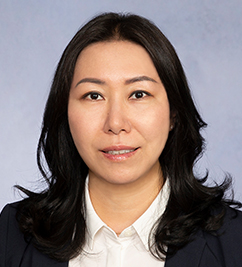New research explores importance of educators’ identities in multilingual learner education

By Hannah Haynes
A new research paper sheds light on the personal journeys of bilingual/ESL preservice teachers – students who are preparing to become teachers by completing a teacher education program, uncovering the ways their linguistic and ethnic identities shape their development as educators.
WIDA researcher Hannah Park wrote the research paper, which examined the multimodal autobiographies of 30 preservice teachers, most of them first-generation college students. These narratives offer insight into how their cultural and linguistic experiences influence their professional growth and teaching motivations.
Understanding the teachers behind the classrooms
Park has collaborated with experts in the areas of teacher education, educational psychology, educational policy, applied linguistics and TESOL throughout her career. She has worked with multilingual learners and educators for over 15 years and explained that the paper is part of her long-standing commitment to applying the latest theories in education to support teachers and students alike. This research provides a crucial window into the lived experiences of bilingual heritage speakers who aim to work with multilingual learners.
“These teachers bring a wealth of cultural and linguistic assets into the classroom,” Park shared. “Their identities—rooted in their family and community backgrounds—are invaluable, not just to their future multilingual students, but to the entire educational landscape.”
The autobiographies, crafted using multimodal literacy projects, allowed participants to reflect on their lives using various forms of communication, including images, videos and written text. This multimodality, Park explained, goes beyond conventional writing and speaking, enabling the preservice teachers to deeply explore and express the cultural and linguistic factors that have influenced their personal and professional paths.
Challenges and catalysts: Personal journeys as inspiration
Many of the participants recounted difficult transitions to English-only classrooms, struggles with maintaining their heritage language and challenges with language proficiency. For these educators, their personal difficulties often became a driving force behind their desire to teach. Park noted that many were inspired to pursue a career in education because of the hardships they experienced as bilingual learners.
“Their experiences of feeling inadequate in either English or their heritage language pushed them to want to do better for their future students,” she said. “They understand firsthand the struggles of being a multilingual learner, which makes them uniquely equipped to support their students emotionally and academically.”
One significant aspect of the research is the focus on these participants being predominantly first-generation college students. Many came from families where English was not the primary language, and they often navigated complicated linguistic landscapes at home, where code-switching between languages was common. These experiences not only shaped their personal identities, but also influenced their approach to teaching and family engagement in the classroom.
Implications for teacher preparation programs
The research holds valuable lessons for teacher preparation programs. Park emphasized that understanding the cultural and linguistic backgrounds of preservice teachers is key to supporting their professional development. For these future educators, the personal often becomes intertwined with the professional, meaning that teacher preparation programs need to be more intentional in addressing the specific needs of bilingual heritage speakers.
“Many of these teachers have a deep understanding of the challenges multilingual learners face,” Park said. “Teacher preparation programs should leverage these insights and provide support that helps these educators translate their lived experiences into effective teaching strategies.”
Family engagement was a particularly prominent theme in the participants’ autobiographies. Many of the preservice teachers highlighted the impact of language dynamics within their families, and how these experiences shaped their views on the importance of engaging students’ families in the learning process. This, Park noted, positions them to create more inclusive classroom environments where families play an active role in their children’s education.
WIDA’s role in supporting multilingual educators
As a researcher at WIDA, Park hopes the findings from the research paper will inform the organization’s efforts to develop resources for bilingual and ESL educators. WIDA is already well known for its work in developing language development standards, and this research adds another layer to their understanding of the needs of multilingual learners and their teachers.
Park’s insights into how bilingual educators understand and implement educational standards could help WIDA refine their professional development offerings. She envisions future initiatives that will focus on helping bilingual preservice teachers navigate the complexities of lesson planning, content integration and social-emotional learning in ways that honor their linguistic and cultural backgrounds.
Looking ahead
As for the next steps, Park is eager to continue exploring the intersection of identity and teaching, particularly how it influences bilingual educators’ approaches to working with multilingual learners. She also sees potential for WIDA to collaborate with higher education institutions to better support first-generation bilingual educators through tailored teacher preparation programs.
Ultimately, Park says this research underscores the importance of valuing educators’ personal experiences and recognizing those experiences as assets in the classroom. “These teachers are not just bilingual; they are cultural and linguistic bridges who can empower their students to succeed in a multilingual world,” she said.
For teachers and educators working with multilingual learners, this research offers a reminder that the identities, languages and cultures students bring into the classroom are invaluable resources—and so are the educators who share those experiences.





